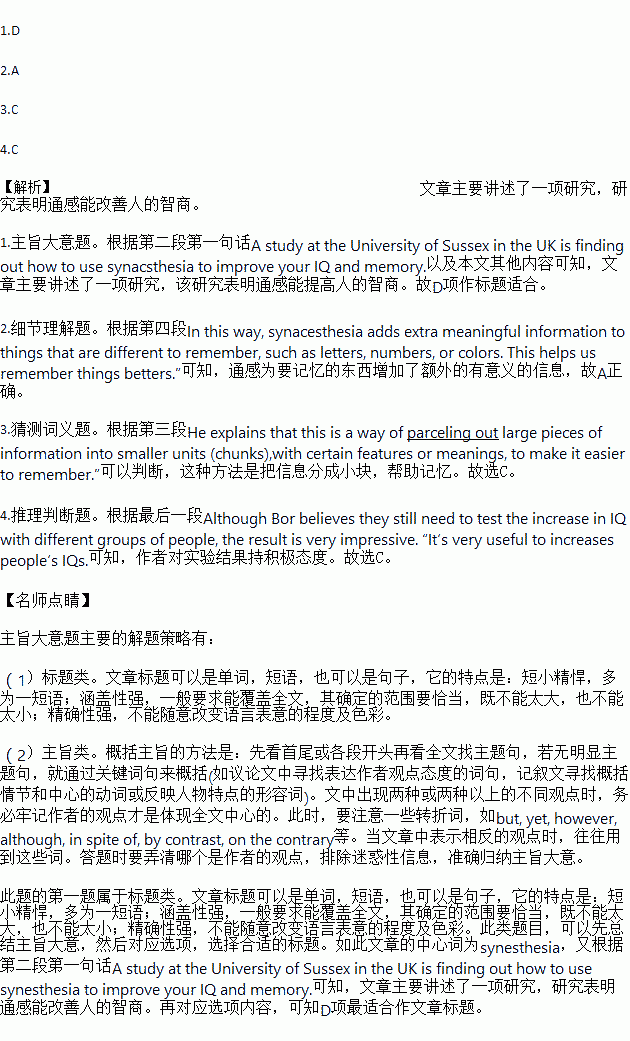题目内容
Some creative people see colors when they hear different sounds. Others hear voices when they see words and numbers. What they experience is called synaesthesia(通感)。
A study at the University of Sussex in the UK is finding out how to use synacsthesia to improve your IQ and memory. The study leaders Danil Bor has been working on exploring memory for a number of year. Bor says that carrying out these tests has given them the opportunity to find out more about how we use different kinds of memory.
Bor based his latest research on something scientists already know a lot about “chunks”. He explains that this is a way of parceling out large pieces of information into smaller units (chunks), with certain features or meanings, to make it easier to remember.” When I gave you my phone number, 01274737271, you probably remember it as 012-74-73-72-71, or something similar. If you can remember 012 and then 74, you can remember the rest by its features. You can get some amazing benefits from chunks.”
In this way, synacesthesia adds extra meaningful information to things that are different to remember, such as letters, numbers, or colors. This helps us remember things betters.” All these signs are pointing towards synaesthesia being connected to greater abilities to do certain things, certain jobs.” says Bor. “So, the study began as a way to test that.”
They wanted to see if they could create a way to learn about synaesthesia, and use its benefits to help everyone. In the study, they trained volunteers for 10 minutes a day for a week. The results were not huge, but impressive.
They discovered that after training, the volunteers were able to pass the normal synaesthesia tests and their IQ jumped up about 12 points. Although Bor believes they still need to test the increase in IQ with different groups of people, the result is very impressive. “It’s very useful to increases people’s IQs. Even when the group are already quite clever, like the students who take part in this study.” he said.
1.Which is the best title for this passage?
A. Synaesthesia, a Common Phenomenon B. Synaesthesia and Chunks
C. What Synaesthesia Tells Us? D. Synaesthesia Helps you Improve IQ
2.How does synaesthesia improve memory?
A. Synaesthesia adds news meanings to memory materials.
B. Synaesthesia is connected to greater abilities to do certain things.
C. Synaesthesia simplifies the memory process.
D. Synaesthesia blends blends various methods together.
3.What does “parcel out” in paragraph 3 mean?
A. Submit. B. Enlarge.
C. Break. D. Arouse.
4.From the passage, Bor feels ________ about the result of the test.
A. doubtful B. worried
C. optimistic D. uncertain
 新思维寒假作业系列答案
新思维寒假作业系列答案

 e care him. Therefore, they asked me to look after her over the weekend. We bought some vegetable and fruit in the supermarket. I also bought him a toy, that he loved very much. On our way back home, he offers to help me with the bags. Seeing this lovely and happy boy, and I couldn't help think of my childhood. How unforgettably a time it was!
e care him. Therefore, they asked me to look after her over the weekend. We bought some vegetable and fruit in the supermarket. I also bought him a toy, that he loved very much. On our way back home, he offers to help me with the bags. Seeing this lovely and happy boy, and I couldn't help think of my childhood. How unforgettably a time it was!